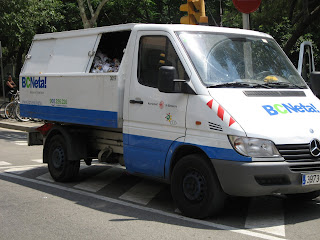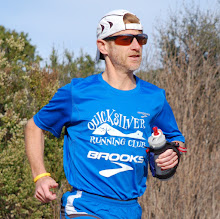
 Karine in front of Mont Blanc, on the Italian side
Karine in front of Mont Blanc, on the Italian sideWhen I met Scott Jurek after Miwok in May where he placed 5th overall, he admitted that he didn't feel that great on trails after having trained so hard on roads, trying to qualify for the world championships of 100K (Canada, this July). Having missed the qualification by a few minutes in such a bad weather begining of 2007, he focused back on trail running and had an outstanding Hardrock, winning and setting a new course record. I hope he will do well at this year's UTMB for his first participation. And that he has the opportunity to review the trail as I just did, before.

What makes Karine's career in ultra praticularly outstanding is her ability to combine performances on both roads and trails. Karine has won the French Nationals of 100K road 7 times in a row (2001-2007). This year, she also won the National title for the 24-hour road race. On the trails, in addition to her participations to Western States and her victory at the UTMB 2006, she won many races including the Jeep Raid of La Réunion and Les Templiers race, 9 times.
Tips
Running and training with such a champion is not only motivational. It is also the opportunity to learn and progress. Here are some tips I gathered this week.
- Poles or no poles? When I joined this week's training group (see my coming UTMB training camp report), I was the only one to carry bottles (the American way...), when the 7 others were using poles in the uphills. After 4 days, I was pleased that Bruno was questioning the use of poles for Karine for the upcoming UTMB race. I don't deny it may provide some help when poles are properly used, and I'm excited to try this technique. In the meantime, I find reassuring it's not necessary to perform well, even on this course.
- Bottles or Camel Back? The question is not worth asking if you want to use poles. But, in any case, you need to carry so much stuff on the UTMB course that you need a backpack. So, adding a fluid puch to it or bottle holders on the shoulder straps, make a lot of sense, freeing your hands and arms from the weight of the bottles.
- Nutrition. Karine plans on writing a book on the topic of nutrition for ultra runners, so I should not disclose her secrets. Just three tips in the meantime. I already knew I should avoid acidic fruits before a race, but I didn't realize that it was true between races too. The second tip is to stop milk and diary products in case of inflammation. And, a third one is to drink some Green Magma, like Karine, and Scott Jurek!
- Knowledge of the course. A precise knowledge of the course of a race is definitely very beneficial. I could experience it at Western States, it helps to have trained through the toughest parts, especially for mental preparation. What I learned this week is the level of details of Bruno's knowledge of the course: turns, type of terrain, setting of aid stations, pace, time keeping/tracking, etc. With such details reported on the road book.
- Keep going. Last but not least, Karine impressed me by her persistent walking and running even when we got tired in the toughest uphills of this course. Agnès doesn't like the nickname I gave Karine for that: la teigne (ringworm)! I realize it's not nice, but it captures for me all the tenacity which makes Karine such a champion.
What's next for Karine?

Acknowledgement
Karine, thank you for being such a model of tenacity, kindness, natural and modesty, in France and internationally. It has been very inspirational to run with you this week, around the top of Europe, and learning a few tips from you and Bruno. I hope to come back soon to run the big race (UTMB) with some friends from California. Good luck on August 24 and 25 to defend your title (Nikki's presence may help you setting a new course record!), and for the continuation of your career in ultra running!

With Karine, in front of the Grandes Jorasses, at the Refuge Bertone

 The second trick comes less than one mile after. You'll hit a main/busy artery which you need to cross, leaving Malakoff and entering in Chatillon. There are a few new buildings, residential and commercial, and often construction which makes the bike lane difficult to find sometimes as some of the sections might be closed (like this summer 07). I suggest you go around a couple of blocks as shown below (and you can check
The second trick comes less than one mile after. You'll hit a main/busy artery which you need to cross, leaving Malakoff and entering in Chatillon. There are a few new buildings, residential and commercial, and often construction which makes the bike lane difficult to find sometimes as some of the sections might be closed (like this summer 07). I suggest you go around a couple of blocks as shown below (and you can check  After that, it's pretty much straightforward for 6-7 miles until Massy, one of the terminal stations of RER B. All the way you'll follow the TGV and RER tracks, but on a trail going mostly through green areas (trees, bushes). Most of the cities you will cross have RER station which is an easy ride back to Paris if you want or need to shorten your run. Take some cash with you in case.
After that, it's pretty much straightforward for 6-7 miles until Massy, one of the terminal stations of RER B. All the way you'll follow the TGV and RER tracks, but on a trail going mostly through green areas (trees, bushes). Most of the cities you will cross have RER station which is an easy ride back to Paris if you want or need to shorten your run. Take some cash with you in case. The park opens at 8am during the week, 9am on weekends. And, from June to September, closes at 9:30pm, which is convenient if you are jet lagged and want to run at the end of the day.
The park opens at 8am during the week, 9am on weekends. And, from June to September, closes at 9:30pm, which is convenient if you are jet lagged and want to run at the end of the day. Enjoy and,
Enjoy and,  The layout of the city is rather simple, around the downtown area: a grid of large avenues with a few diagonals, like in Washington DC, with the impressive Avinguda Diagonal and its famous brand stores. It's when you get in the hills (e.g. Montjuic Park or near the Guell Park) that it's getting more confusing.
The layout of the city is rather simple, around the downtown area: a grid of large avenues with a few diagonals, like in Washington DC, with the impressive Avinguda Diagonal and its famous brand stores. It's when you get in the hills (e.g. Montjuic Park or near the Guell Park) that it's getting more confusing.








